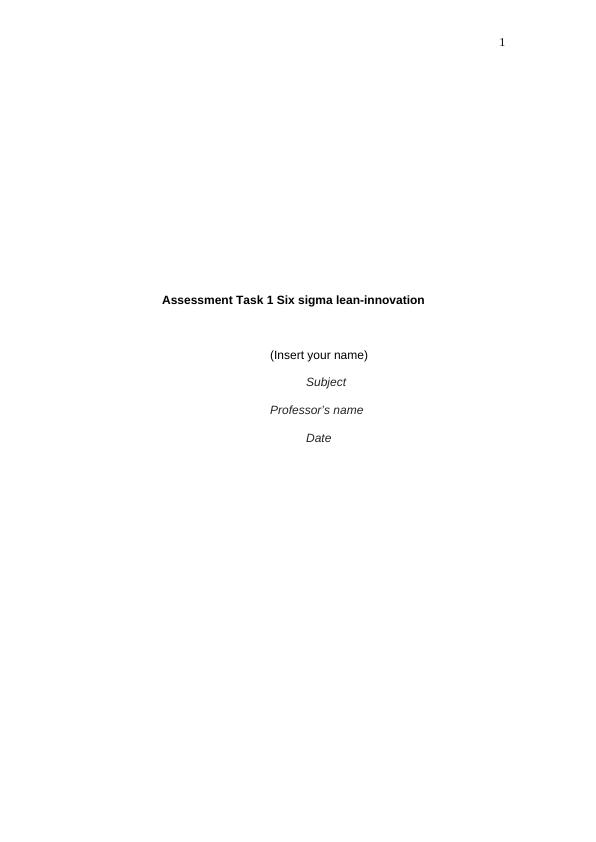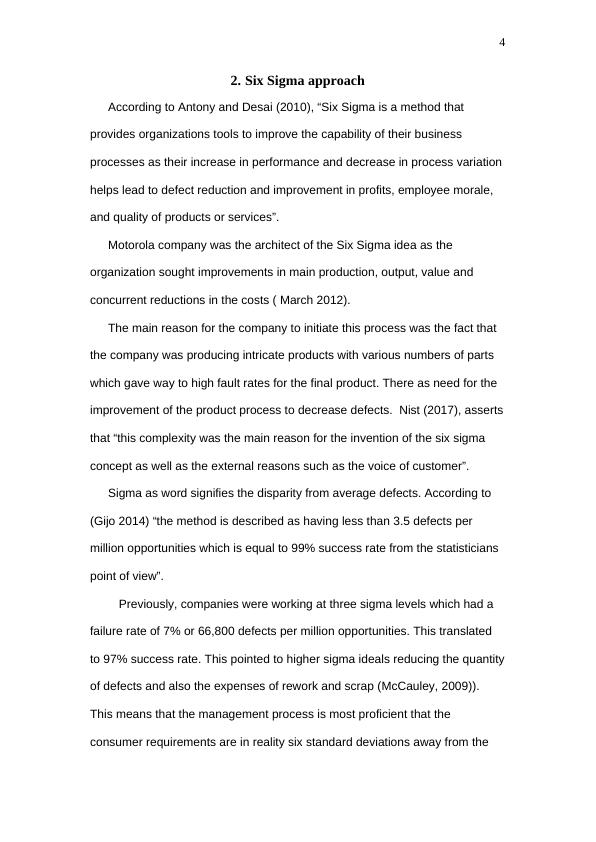Six Sigma and Lean Approaches in Quality Management
Added on 2023-04-21
19 Pages3713 Words346 Views
1
Assessment Task 1 Six sigma lean-innovation
(Insert your name)
Subject
Professor’s name
Date
Assessment Task 1 Six sigma lean-innovation
(Insert your name)
Subject
Professor’s name
Date

2
Table of Contents
Quality Management Methods.......................................................................................3
1. Research methodology........................................................................................3
2. Six Sigma approach.............................................................................................4
Six Sigma as an quality advancement process.......................................................6
3. DMAIC...............................................................................................................7
Six sigma advantages.............................................................................................9
The six sigma analysis...........................................................................................9
4. The Lean............................................................................................................10
Lean approach Advantages..................................................................................11
The lean approach analysis..................................................................................12
The Lean and Six Sigma (LSS) integration.........................................................12
5. Findings.............................................................................................................14
6. Conclusion.........................................................................................................14
List of references......................................................................................................16
List of figures
Figure 1 Six sigma defects rate......................................................................................5
Figure 2 DMAIC defined...............................................................................................8
Figure 3 Lean management defined.............................................................................11
Figure 4 Lean six sigma...............................................................................................13
Table of Contents
Quality Management Methods.......................................................................................3
1. Research methodology........................................................................................3
2. Six Sigma approach.............................................................................................4
Six Sigma as an quality advancement process.......................................................6
3. DMAIC...............................................................................................................7
Six sigma advantages.............................................................................................9
The six sigma analysis...........................................................................................9
4. The Lean............................................................................................................10
Lean approach Advantages..................................................................................11
The lean approach analysis..................................................................................12
The Lean and Six Sigma (LSS) integration.........................................................12
5. Findings.............................................................................................................14
6. Conclusion.........................................................................................................14
List of references......................................................................................................16
List of figures
Figure 1 Six sigma defects rate......................................................................................5
Figure 2 DMAIC defined...............................................................................................8
Figure 3 Lean management defined.............................................................................11
Figure 4 Lean six sigma...............................................................................................13

3
QUALITY MANAGEMENT METHODS
Different organizations use different approaches in improving quality of its
products. Six sigma and lean approaches are the two major tools used in
improving quality. The basis of the six sigma approach was initiated by
Motorola Company with an objective of minimizing variation in the production
processes while the lean approach was initiated by Toyota Motor Corporation
with an intention of minimizing waste in its production.
The two concepts complement each other. When a company intends to
achieve high quality in production, it must use both approaches. Lean
approach cannot be able to provide the arithmetical command of a procedure
while six sigma does not improve the required pace of the process. According
to Honeywell (2012), “lean and six sigma organizations have some sort of
improvements by implementing the other half”. This gives the lean Six Sigma
(LSS) meaning. The paper analyses the six sigma approaches and the lean
approach by analyzing different companies that uses the two approaches.
1. Research methodology
The procedure and the techniques that were used to recognize, decide
on, process and give the analysis of the different approaches that are used in
quality management process were determined from researching on various
research works on quality management management approaches as well
topics from previous studies. The paper evaluated different sources to come
up with valid and reliable results. In addition, the paper gives a well
researched analysis of the meaning of Lean, Six Sigma and DMAIC
approaches. This gives a clear definition of the three and analyzes their
fundamental importance.
QUALITY MANAGEMENT METHODS
Different organizations use different approaches in improving quality of its
products. Six sigma and lean approaches are the two major tools used in
improving quality. The basis of the six sigma approach was initiated by
Motorola Company with an objective of minimizing variation in the production
processes while the lean approach was initiated by Toyota Motor Corporation
with an intention of minimizing waste in its production.
The two concepts complement each other. When a company intends to
achieve high quality in production, it must use both approaches. Lean
approach cannot be able to provide the arithmetical command of a procedure
while six sigma does not improve the required pace of the process. According
to Honeywell (2012), “lean and six sigma organizations have some sort of
improvements by implementing the other half”. This gives the lean Six Sigma
(LSS) meaning. The paper analyses the six sigma approaches and the lean
approach by analyzing different companies that uses the two approaches.
1. Research methodology
The procedure and the techniques that were used to recognize, decide
on, process and give the analysis of the different approaches that are used in
quality management process were determined from researching on various
research works on quality management management approaches as well
topics from previous studies. The paper evaluated different sources to come
up with valid and reliable results. In addition, the paper gives a well
researched analysis of the meaning of Lean, Six Sigma and DMAIC
approaches. This gives a clear definition of the three and analyzes their
fundamental importance.

4
2. Six Sigma approach
According to Antony and Desai (2010), “Six Sigma is a method that
provides organizations tools to improve the capability of their business
processes as their increase in performance and decrease in process variation
helps lead to defect reduction and improvement in profits, employee morale,
and quality of products or services”.
Motorola company was the architect of the Six Sigma idea as the
organization sought improvements in main production, output, value and
concurrent reductions in the costs ( March 2012).
The main reason for the company to initiate this process was the fact that
the company was producing intricate products with various numbers of parts
which gave way to high fault rates for the final product. There as need for the
improvement of the product process to decrease defects. Nist (2017), asserts
that “this complexity was the main reason for the invention of the six sigma
concept as well as the external reasons such as the voice of customer”.
Sigma as word signifies the disparity from average defects. According to
(Gijo 2014) “the method is described as having less than 3.5 defects per
million opportunities which is equal to 99% success rate from the statisticians
point of view”.
Previously, companies were working at three sigma levels which had a
failure rate of 7% or 66,800 defects per million opportunities. This translated
to 97% success rate. This pointed to higher sigma ideals reducing the quantity
of defects and also the expenses of rework and scrap (McCauley, 2009)).
This means that the management process is most proficient that the
consumer requirements are in reality six standard deviations away from the
2. Six Sigma approach
According to Antony and Desai (2010), “Six Sigma is a method that
provides organizations tools to improve the capability of their business
processes as their increase in performance and decrease in process variation
helps lead to defect reduction and improvement in profits, employee morale,
and quality of products or services”.
Motorola company was the architect of the Six Sigma idea as the
organization sought improvements in main production, output, value and
concurrent reductions in the costs ( March 2012).
The main reason for the company to initiate this process was the fact that
the company was producing intricate products with various numbers of parts
which gave way to high fault rates for the final product. There as need for the
improvement of the product process to decrease defects. Nist (2017), asserts
that “this complexity was the main reason for the invention of the six sigma
concept as well as the external reasons such as the voice of customer”.
Sigma as word signifies the disparity from average defects. According to
(Gijo 2014) “the method is described as having less than 3.5 defects per
million opportunities which is equal to 99% success rate from the statisticians
point of view”.
Previously, companies were working at three sigma levels which had a
failure rate of 7% or 66,800 defects per million opportunities. This translated
to 97% success rate. This pointed to higher sigma ideals reducing the quantity
of defects and also the expenses of rework and scrap (McCauley, 2009)).
This means that the management process is most proficient that the
consumer requirements are in reality six standard deviations away from the

End of preview
Want to access all the pages? Upload your documents or become a member.
Related Documents
Implementation of Lean Six Sigma in Small and Medium Scale Enterpriseslg...
|7
|4014
|402
19. 19 PROFESSIONAL PROJECT. : PROFESSIONAL PROJECT. Prlg...
|24
|6411
|2
Lean Six Sigma Framework for Waste Managementlg...
|14
|554
|65
Impact of Lean Six Sigma Framework on Performancelg...
|11
|1999
|38
Aligning Lean Six Sigma Strategies with Environmental Challenges: A Case Study of Australian Paperlg...
|21
|4882
|354
Implementation of Strategic Tools in Operations Managementlg...
|11
|2735
|84
